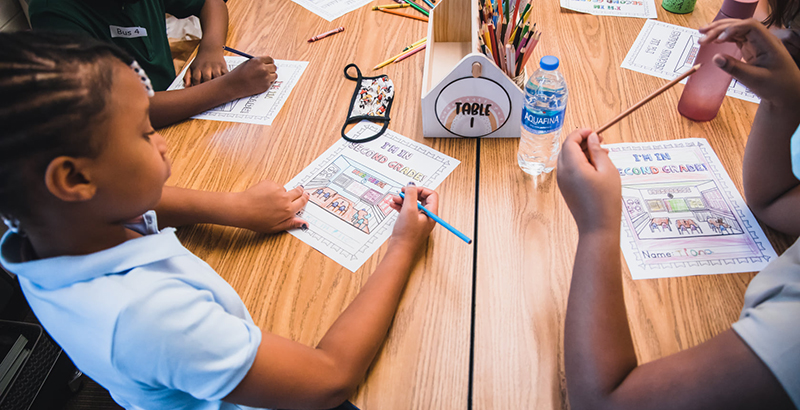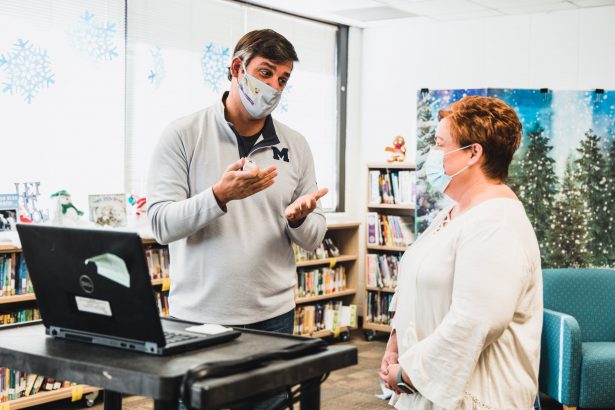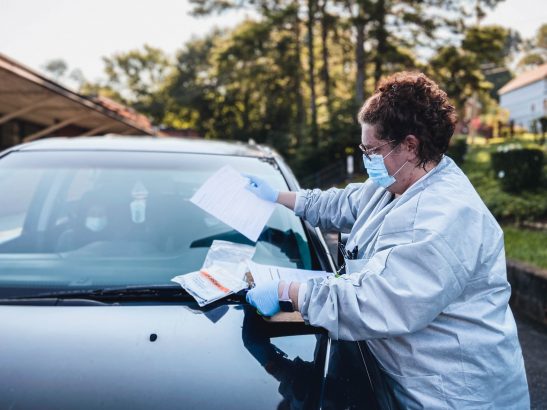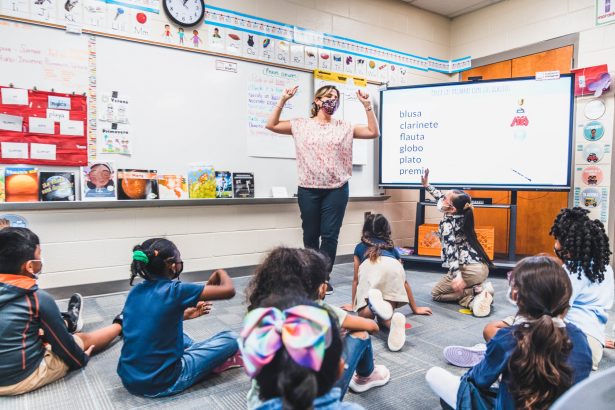More Districts Scrap Mask Mandates and Embrace ‘Test-to-Stay’ Measures to Spare Students from Quarantine

Get stories like this delivered straight to your inbox. Sign up for The 74 Newsletter
Throughout the pandemic, Marietta City Schools Superintendent Grant Rivera has been at the forefront of the science on COVID-19.
In December and January, his 8,900-student district just north of Atlanta partnered with the Centers for Disease Control and Prevention to study classroom virus transmission, ultimately adjusting their distancing protocols to reduce spread. In September, after reading an op-ed written by a Harvard University professor that proposed using rapid antigen tests to give healthy kids an alternative to quarantine, he reached out directly to the author asking about the model — and ultimately implemented the “test-to-stay” scheme in his schools. Now, the district is planning to hold school-based vaccination clinics for students this month as COVID shots roll out for younger kids.
But despite a keen eye for the latest coronavirus safety research, Rivera made another move in mid-October that many parents had clamored for, but health experts cautioned against: He lifted Marietta’s mask requirement.
“We tried to get to a solution that we think is good for our community,” the superintendent told The 74. “Could I give kids a bit more sense of normalcy back that they haven’t had for two years? I think that’s a question we’re grappling with.”
The move typifies a trend emerging nationwide, as school leaders respond to falling pediatric COVID caseloads.
At least a dozen districts that previously required face coverings are now mask-optional, including Orange County, Florida; Casey County, Kentucky and Fayette County, Georgia. Of the 200 largest U.S. school systems, 135 now have mask mandates — down from 150 on Oct. 1 and lower than at any point this school year since mid-August, according to numbers from Burbio, a data service that has tracked school policy through the pandemic.
That pattern worries Benjamin Linas, professor of medicine at Boston University.
Over the summer, the health expert used simulation modeling technology to predict how many positive COVID cases would be transmitted in schools, depending on their vaccination rates and mitigation measures. The working paper that he and his team published in August recommended that schools drop universal face-covering rules only once 80 percent of students and staff are fully immunized and community transmission is below 10 cases per 100,000 people.
Currently, the U.S. averages 22 daily cases per 100,000. And while as many as 90 percent of school staff nationwide are vaccinated, just under half of eligible youth have received both shots.
Vaccines for children ages 5 to 11 are expected to roll out in days and as many as two-thirds of parents with children in the age group plan to have their kids immunized, according to surveys, but a significant share may wait before doing so, they say. About a quarter said they definitely would not vaccinate their children.
With vaccination rates as they currently stand, school buildings are largely full of people unprotected against the virus, Linas pointed out.
“That is a setup for trouble in the future, having ongoing smoldering transmission because people are under vaccinated and we’re not wearing masks,” he told The 74. “The virus continues, new variants emerge — those threats are real.”

Other experts, including Joseph Allen, the Harvard public health professor that Rivera corresponded with about Marietta’s test-and-stay approach, argue that schools should take a more dynamic approach to masking requirements, dropping them when transmission falls. Given the current situation, he advocates for the end of all school face-covering requirements by January, if not sooner.
“If things change for the worse — and they might — then we just pull the masks back out of the drawer. But we must be just as willing to put them away when things look better,” Allen wrote in an October Washington Post op-ed.
At the state level, Massachusetts has set a benchmark that aligns with the Linas’s recommendation, dangling mask-optional status for any school that reaches 80 percent student and staff vaccination. But new guidance in North Carolina allows schools to scrap face coverings where community transmission is low and Louisiana gives districts the option to do the same if they maintain stringent quarantine rules. Neither policy accounts for immunization levels in the school community.
Georgia, similarly, is a state that gives local school leaders the power to set their own coronavirus safety policies. In Marietta, the district’s program for testing students and staff who may have been exposed to the virus played into the calculus for Rivera’s decision to go mask-optional.
“There’s an interplay between these approaches,” the superintendent said. “Your approach to masks will impact the distance at which you are identifying close contacts — three feet vs. six feet, indoors. The number of students who are identified as close contacts, that drives your test-and-stay demand.”
Because 98 percent of would-be quarantines in his district never ultimately tested positive, Rivera hoped the testing policy, which the district has funded partially through relief dollars, would keep students learning in the classroom, regardless of whether they were wearing masks.
Out of 281 tests so far administered by the program, 271 have come back negative, the superintendent said — meaning those students have been able to stay in the school building.

The “test-to-stay” strategy has been adopted by districts across the country this fall and is lauded by public health experts. The CDC said in mid-October that they are considering incorporating the approach into their school coronavirus guidance.
Regarding masking, the CDC recommends universal use, but in practice, the policies have been much more controversial, with eruptions over the mandates in dozens of districts.
“I felt like I’ve had to navigate this path by myself,” said Rivera. “I feel like most people sit on either side of it. Either it’s, ‘Nope, we have to follow blindly what the CDC says,’ or we pretend that COVID doesn’t exist. And I don’t think either one of those is right, there’s a balance in the middle.”
The softened masking rules have had some real benefits, according to teachers in the district. Foreign language classes, for instance, were strained when everyone had to cover up.
“It is really tough when kids are learning a new language for the first time to pronounce new sounds, not seeing how to form their mouth, or [seeing] my mouth because I’m covered up in a mask,” Wendy Locke, a French teacher at Marietta High School, told The 74.
Barbie Esquijarosa, who teaches English to non-native speakers at the high school, agrees that face coverings make school more difficult for young people learning English. But she also worries that the mask-optional policy presents an added stressor for the students she teaches, many of whom may live with older relatives and lack health insurance.
“They come in concerned,” said Esquijarosa. “They’re wearing [the mask] the whole time. They’ll stay away from the kids who don’t wear the masks.”
What’s more, many of her students lack transportation, meaning they aren’t able to participate in Marietta’s test-and-stay program if they have possible COVID exposures.
Rivera recognizes that the program is accessible only to students with transportation and is working to designate a bus to pick up kids for COVID testing. But as of yet, no such route is in operation. Like many other districts across the country, Marietta’s bus driver reserves are stretched thin amid wider labor shortages facing schools and the U.S. economy.

Elsewhere, some school districts have taken an opposite stance on masking. When the department of health in Douglas County, Colorado moved to remove face-covering mandates, the school district sued on behalf of nine medically vulnerable students — winning a temporary restraining order on the new rule.
“No parent should be forced to choose between sending their child to school and risking their child’s health, and no family should have to fear that their child may face life-threatening illness just to access their right to a great education,” Superintendent Corey Wise said in a statement.
Back in Marietta, there has been no increase in coronavirus infections since Rivera dropped universal masking rules. Total infections have fallen from 233 in the first five weeks of schools to 143 in the seven weeks that followed, according to the district.
Still, Linas, the Boston University medical expert, cautions against the mask-optional policy.
Breathing room now for students and staff may mean breathing room for the virus — to mutate and evolve — in the long run, he said.
“It just doesn’t make sense to start rolling those dice when we’re so close to the actual finish line.”
Get stories like these delivered straight to your inbox. Sign up for The 74 Newsletter

;)
